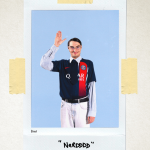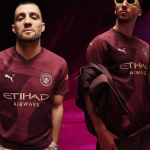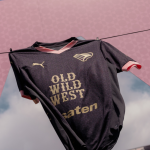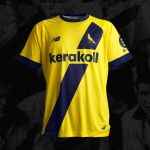
What year was it for Nike?
The 2023/24 season represented a return to basics for Nike, but with some important innovations
October 19th, 2023
Last season was a return to templates for Nike, a path the company seemed to have abandoned and which is still prominent in this year's jerseys. Both the Elite, Premium and Standard teams therefore used templates in aesthetic continuity with the previous year, not a surprise given how brands try to make certain trends last over time in order to impose them on the market and repay the investment made. Thus, the major teams that wear the Swoosh on their chests have not seen their jerseys change drastically, with especially the home kits remaining more or less unchanged due to a design that is now so historicised that it does not stand up to major shake-ups.
For example, Atletico Madrid's first jersey abandoned those wavy stripes that had made last season's jersey one of the least sold in Colchoneros history, similarly Barcelona have simplified theirs by returning to the origins of the blaugrana jersey. After Nike included the Vaporknit 2022 template last season, this is the season of restoration, looking back to the 90s and 00s aesthetics used mainly in the design of the away and third kits.
The 90s videogame aesthetic
One of the keys chosen by Nike was the celebration of the retro aesthetics associated with the first video games and personal computers, complete with pixelation and grainy bands. An example of this trend is clearly the Inter Home jersey, with its black and blue stripes reminiscent of a badly tuned television, or Liverpool's away kit, inspired by the away kit of the 1995-1996 season and reinterpreted by tonal patterns with a pixelated effect. Chelsea's away jersey also draws from the archives of the early 2000s with a screensaver-like gridded effect.
But beyond the design of the jerseys, it is also the storytelling and shooting styling that place Nike firmly in that golden decade at the turn of the millennium when it became to all intents and purposes the coolest brand in football. Recovering that vibe made of highlighter colours, intrusive graphics and streetwear aesthetics is in Nike's plans, also launching lifestyle collections that are decidedly urban and with an edge in open contrast to the cleaner style of its direct competitors.
Nike Grind
Nike has for seasons been pursuing the goal of making football kits sustainable, lowering the impact the entire supply chain can have on the environment. An extremely ambitious project that is obviously also having an effect on the design and aesthetics of the jerseys themselves, changing the fabrics used and other distinctive elements, such as company crests and the iconic Swoosh logo itself. The latter are in fact made of Nike Grind, the new material composed largely of post-industrial production waste, used and defective shoes and end-of-process materials.
A circular process that avoids waste within Nike factories and can be used for a wide variety of products, from home soundproofing to playgrounds and even game jerseys. The grainy effect typical of recycled materials is evident in the Barcelona third jersey, turquoise with blue and garnet accents, but also in the logos made for the Inter and Tottenham third kits. A choice that may become increasingly common in the coming years, given the necessary interest of brands and clubs in sustainability.
New audiences, new jerseys
It is certainly not news that Nike is divesting itself of club and player sponsorship in Europe in an attempt to win over new audiences less familiar with the game of football, more out of willingness than passion. Thus Nike has invested heavily in the Saudi League, given also the presence of its main asset Cristiano Ronaldo, producing the shirts of two of the most important teams, CR7's Al-Nassr and Karim Benzema's Al Ittihad. Notwithstanding the many supply problems encountered in recent months that have made Al-Nassr's new jerseys unavailable, having conquered such a large and rich market from the outset has positioned Nike ahead of its direct competitors in view of the continuing evolution of Arab football.
Similarly, Nike used the Women's World Cup to reinforce the work it has done in recent years, designing special jerseys for the national teams involved and releasing a series of videos through its social channels. As it did in the 2000s, when the brand revolutionised the sports communication market with iconic commercials such as "Winner Stays On" and "The Cage", Nike has chosen to make six of the world's strongest female footballers the stars of its advertising campaign, re-entering a potentially very strong market by focusing on the aesthetic keys it does best: Y2K nostalgia and street style.












